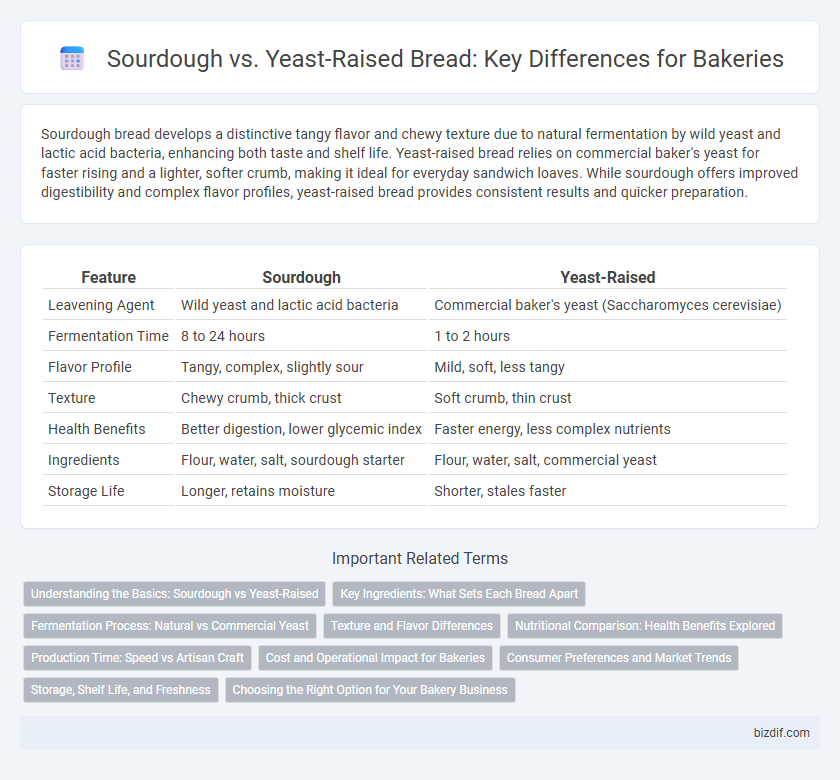Sourdough bread develops a distinctive tangy flavor and chewy texture due to natural fermentation by wild yeast and lactic acid bacteria, enhancing both taste and shelf life. Yeast-raised bread relies on commercial baker's yeast for faster rising and a lighter, softer crumb, making it ideal for everyday sandwich loaves. While sourdough offers improved digestibility and complex flavor profiles, yeast-raised bread provides consistent results and quicker preparation.
Table of Comparison
| Feature | Sourdough | Yeast-Raised |
|---|---|---|
| Leavening Agent | Wild yeast and lactic acid bacteria | Commercial baker's yeast (Saccharomyces cerevisiae) |
| Fermentation Time | 8 to 24 hours | 1 to 2 hours |
| Flavor Profile | Tangy, complex, slightly sour | Mild, soft, less tangy |
| Texture | Chewy crumb, thick crust | Soft crumb, thin crust |
| Health Benefits | Better digestion, lower glycemic index | Faster energy, less complex nutrients |
| Ingredients | Flour, water, salt, sourdough starter | Flour, water, salt, commercial yeast |
| Storage Life | Longer, retains moisture | Shorter, stales faster |
Understanding the Basics: Sourdough vs Yeast-Raised
Sourdough bread relies on natural fermentation using wild yeast and lactic acid bacteria, creating complex flavors and a chewy texture, while yeast-raised bread uses commercial baker's yeast for faster, more predictable fermentation and a lighter, softer crumb. The natural fermentation in sourdough also contributes to better digestibility and longer shelf life, unlike yeast-raised bread which typically requires additives to maintain freshness. Understanding these fundamental differences helps bakers choose the right leavening method based on flavor preference, fermentation time, and desired texture.
Key Ingredients: What Sets Each Bread Apart
Sourdough bread relies on a natural fermentation process using wild yeast and lactic acid bacteria found in a sourdough starter, which contributes to its distinctive tangy flavor and chewy texture. Yeast-raised bread utilizes commercial baker's yeast, primarily Saccharomyces cerevisiae, speeding up fermentation and producing a milder taste with a softer crumb. The key difference lies in the sourdough starter's wild cultures versus the isolated commercial yeast, impacting flavor complexity, rise time, and texture.
Fermentation Process: Natural vs Commercial Yeast
Sourdough bread undergoes a natural fermentation process using wild yeast and lactic acid bacteria present in the environment, resulting in a complex flavor profile and improved digestibility. Yeast-raised bread relies on commercial baker's yeast, which accelerates fermentation and provides consistent leavening but yields a milder taste. The slower fermentation of sourdough enhances nutrient absorption and contributes to longer shelf life compared to faster, yeast-raised breads.
Texture and Flavor Differences
Sourdough bread develops a chewy, dense texture with a tangy, complex flavor due to wild fermentation by natural lactobacilli and wild yeast. Yeast-raised bread, on the other hand, produces a softer crumb and milder taste because of commercial yeast's quicker fermentation. The longer proofing time in sourdough enhances flavor depth and crust crispiness compared to the more uniform texture and subtle flavor of yeast-raised loaves.
Nutritional Comparison: Health Benefits Explored
Sourdough bread contains natural lactobacilli and wild yeast, which help break down gluten and increase the bioavailability of minerals such as magnesium, zinc, and iron, enhancing digestion and nutrient absorption. Yeast-raised bread, typically made with commercial yeast, has a faster fermentation process but lacks the complex nutritional benefits of sourdough, often resulting in higher glycemic response. The prebiotic properties and lower phytic acid content in sourdough contribute to improved gut health and a more balanced blood sugar level compared to standard yeast-raised bread.
Production Time: Speed vs Artisan Craft
Sourdough bread production requires extended fermentation periods, often ranging from 12 to 48 hours, allowing natural wild yeast and bacteria to develop complex flavors and a distinct texture. Yeast-raised bread utilizes commercial yeast, significantly reducing proofing time to 1-3 hours, enabling faster batch production suitable for high-demand commercial bakeries. The slower sourdough process emphasizes artisan craftsmanship and flavor depth, while yeast-raised methods prioritize speed and consistency in volume output.
Cost and Operational Impact for Bakeries
Sourdough production involves higher costs due to longer fermentation times and increased labor intensity, requiring skilled bakers to maintain starter cultures and manage extended proofing schedules. In contrast, yeast-raised bread offers faster turnaround, reducing operational hours and enabling higher daily output, which lowers labor and overhead expenses. While sourdough commands premium pricing because of its artisanal appeal, yeast-raised bread provides bakeries with more predictable costs and scalability for volume-driven sales.
Consumer Preferences and Market Trends
Sourdough bread is gaining popularity among consumers seeking natural fermentation and enhanced flavor complexity, driving market growth in artisanal and health-conscious segments. Yeast-raised bread remains favored for its consistent texture, faster production, and lower cost, supporting mass-market demand. Current trends indicate a rising preference for sourdough in premium bakery offerings, while yeast-raised products dominate everyday staples due to convenience and price efficiency.
Storage, Shelf Life, and Freshness
Sourdough bread typically has a longer shelf life and maintains freshness better than yeast-raised bread due to its natural fermentation process, which creates organic acids that inhibit mold growth. While yeast-raised bread can become stale within two to three days, sourdough can remain fresh for up to a week when stored properly in a cool, dry place. Proper storage in airtight containers or paper bags helps retain sourdough's crusty texture and chewy interior, whereas yeast-raised bread often requires refrigeration or freezing to extend freshness beyond a few days.
Choosing the Right Option for Your Bakery Business
Sourdough offers a distinct tangy flavor and longer shelf life due to natural fermentation, appealing to artisanal bakery markets seeking premium quality. Yeast-raised bread delivers faster proofing times and consistent results, ideal for high-volume production and cost efficiency. Selecting between sourdough and yeast-raised depends on your bakery's target customers, production capacity, and desired product profile to optimize profitability and brand identity.
Sourdough vs Yeast-Raised Infographic

 bizdif.com
bizdif.com